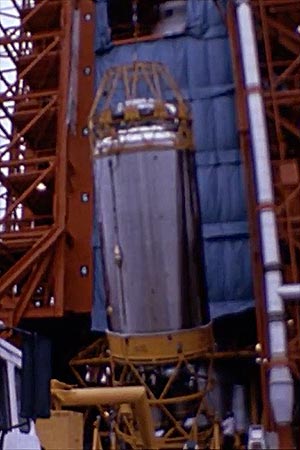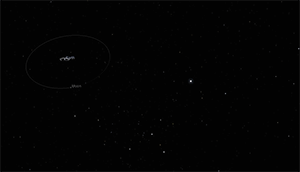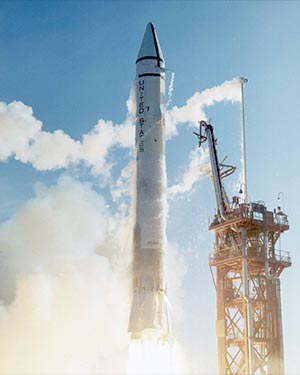November 13, 2020 — A long-lost remnant of an ill-fated moon mission may have just been found as a temporary satellite in Earth orbit.
NASA scientists believe the object, designated 2020 SO, may be the upper stage from a 54-year-old rocket that launched a U.S. robotic probe on an unsuccessful attempt to land on the moon. Observations of the relatively small object have been consistent with it being the booster, but upcoming measurements will help confirm its identity as it spends the next four months looping twice around Earth.
"One of the possible paths for 2020 SO brought the object very close to Earth and the moon in late September 1966," Paul Chodas, director of the Center for Near-Earth Object Studies (CNEOS) at NASA's Jet Propulsion Laboratory (JPL), said in a statement. "It was like a eureka moment when a quick check of launch dates for lunar missions showed a match with the Surveyor 2 mission."
The suspected rocket relic drifted into Earth's sphere of gravitational influence on Sunday (Nov. 8). It will make its closest approach to Earth on Dec. 1, coming within 31,000 miles (50,000 km) of the planet, and then escape back into an orbit around the Sun in March 2021.
Update: A team at the Lunar and Planetary Laboratory at the University of Arizona using NASA's Infrared Telescope Facility on Maunakea, Hawai'i performed follow up spectroscopy observations of 2020 SO confirming that 2020 SO is, in fact, the Surveyor 2 Centaur booster, NASA announced on Dec. 2. The article continues as originally published below.
From the Earth to the moon... and beyond
If the identification is correct, 2020 SO is the upper stage from the Atlas-Centaur rocket that launched the United States' second lunar lander on Sept. 20, 1966. Surveyor 2 was intended as a precursor to the Apollo moon landings and a follow up to the Surveyor 1 spacecraft, which successfully touched down on the moon's Ocean of Storms three months earlier.
Surveyor 2 survived its liftoff from Cape Canaveral, Florida, and safely separated from the 30 foot long by 10 foot in diameter (9.1 by 3 m) Centaur stage, but a failed midcourse maneuver left the lander tumbling and it crashed into its target just southeast of Copernicus crater on the moon three days after it had left Earth.
The spent Centaur upper stage, meanwhile, continued on its planned path beyond the moon and entered an unknown orbit around the Sun to become lost in space.
More than five decades later, astronomers using the Pan-STARRS1 telescope on Maui took note of an object that was following a slightly curved path across the sky, indicating that it was near Earth. (The apparent curvature is the result of the rotation of the observer around Earth's axis as the planet spins, explains NASA).
The object was assumed to be a small asteroid, hence its designation, 2020 SO, by the Minor Planet Center in Massachusetts, but Chodas and his team at CNEOS suspected otherwise.
The object's orbit around the Sun was at about the same distance, nearly circular and in an orbital plane that almost exactly matched that of Earth, which is unusual for a chunk of natural space rock. Further, as astronomers around the world made additional observations, they saw the degree to which the Sun's radiation was changing 2020 SO's trajectory, suggesting that it might not be an asteroid after all.
"Solar radiation pressure is a non-gravitational force that is caused by light photons emitted by the Sun hitting a natural or artificial object," Davide Farnocchia, a navigation engineer at JPL who analyzed 2020 SO's trajectory for CNEOS, said. "The resulting acceleration on the object depends on the so-called area-to-mass ratio, which is greater for small and light, low-density objects."
Solar radiation pressure has a greater effect on hollow objects — such as a spent rocket stage — than it has on solids. And, with the data from more than 170 detailed measurements made over the last three months, including observations conducted by the Catalina Sky Survey in Arizona and the European Space Agency's Optical Ground Station in Spain, the impact of solar radiation pressure on 2020 SO has confirmed that it has a low density.
Shining a light on space history
As 2020 SO approaches Earth, the next step will be to measure its composition to see, for example, if it is coated in paint.
The same process, called spectroscopy, was used to identify another lunar exploration artifact when it re-approached Earth in 2002. Astronomers at the Lunar and Planetary Laboratory at the University of Arizona were able to determine that object J002E3 was the third stage (S-IVB) from the Saturn V rocket that launched NASA's Apollo 12 moon landing mission by detecting its titanium oxide coating.
That stage was thought to be in heliocentric orbit (circling the Sun) after it completed its role in launching NASA's second crew to walk on the moon on Nov. 14, 1969, buts it reemergence 18 years ago led to a revised belief that it instead entered an unstable high Earth orbit. It is now expected to make its next close approach to Earth in the mid-2040s.
As for 2020 SO, it previously came close to Earth a few times in the years since it was launched and will make one more perigee in February 2021, before it departs the vicinity to become a lost piece of space history again. |
|

The Centaur upper stage for NASA's Surveyor 2 mission is seen being erected on the launchpad for a test in June 1966. Fifty-four years after it flew beyond the moon and into an orbit around the Sun, the booster may be back, having been temporarily captured by Earth's gravity well. (16mm film still from San Diego Air and Space Museum Atlas Centaur Heritage Film Collection)

Animation of the orbit of 2020 SO, which was captured by Earth's gravity on Nov. 8, 2020. It will escape in March 2021. Its motion has been sped up a million times faster than real time. (NASA/JPL)

Launch of NASA's Surveyor 2 moon lander atop an Atlas-Centaur rocket on Sept. 20, 1966 from Cape Canaveral, Florida. (NASA) |
